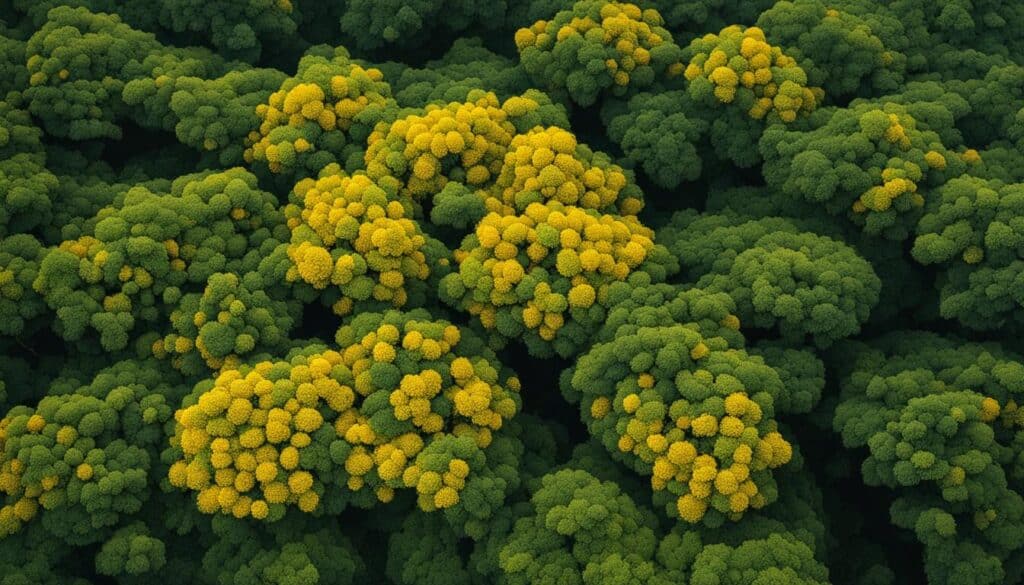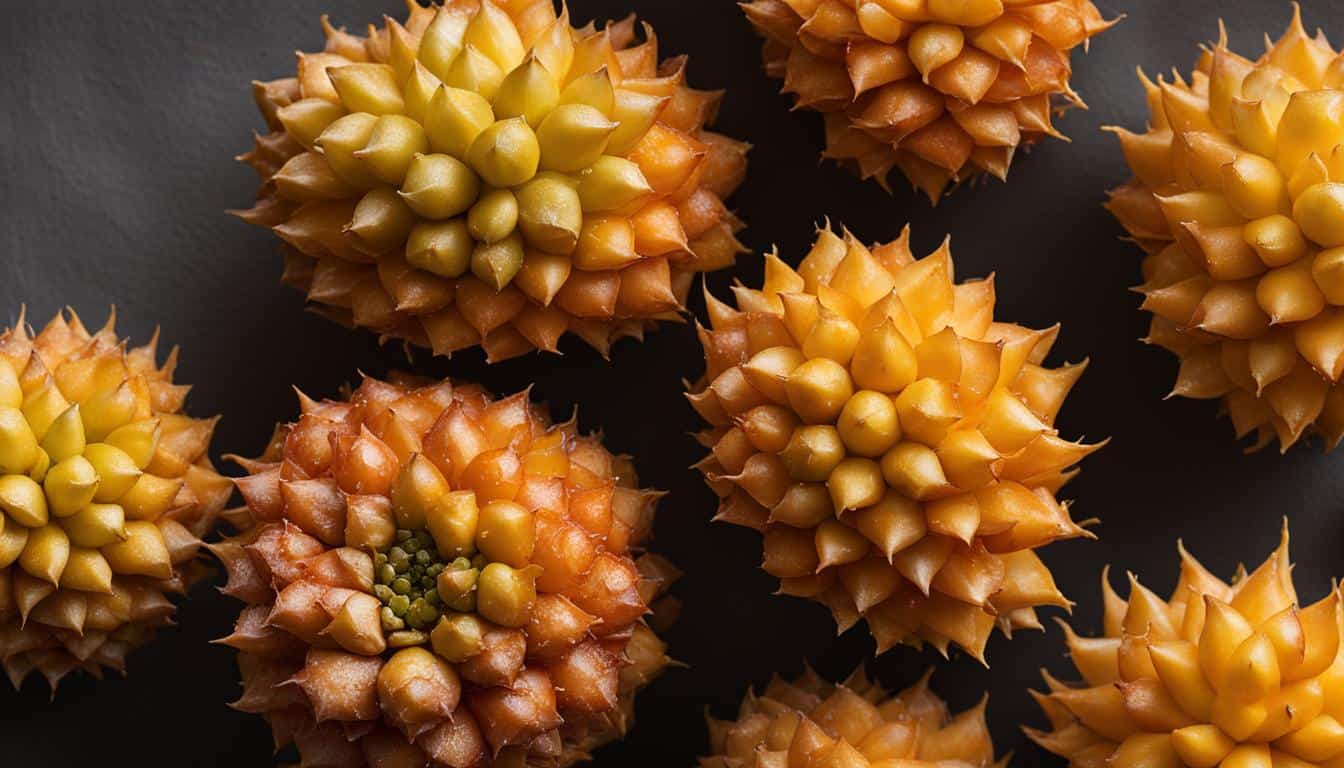Greetings! I’m excited to introduce you to the wonderful world of langsat fruit. This delicious and tropical fruit, also known as Lansium Parasiticum, is sure to tantalize your taste buds and leave you craving for more.
Langsat fruit is native to the Malayan Peninsula and has been enjoyed for centuries in Southeast Asia. Its refreshing sweet and tangy flavor, combined with its unique round shape, makes langsat a delightful treat.
The langsat tree, with its glossy dark green leaves and clusters of round fruits, is truly a sight to behold. These evergreen trees thrive in the humid and tropical climates of Southeast Asia and produce an abundance of langsat fruits during the harvest season, which typically falls between September and November.
But langsat fruit isn’t just delicious; it’s also packed with essential nutrients. From vitamins like Vitamin C, Vitamin A, and B-complex vitamins to minerals like potassium, calcium, iron, and phosphorus, langsat fruit offers a wide range of health benefits.
Key Takeaways:
- Langsat fruit is a sweet and tangy tropical fruit native to Southeast Asia.
- The langsat tree produces round fruits, which are harvested between September and November.
- Langsat fruit is packed with essential nutrients like vitamins and minerals.
- Langsat fruit can be enjoyed fresh or used in various recipes.
- Exploring langsat fruit allows you to discover its cultural and culinary significance.
The Nutritional Value of Langsat Fruit
Langsat fruit is not only delicious but also packed with essential nutrients. It is an excellent source of vitamins, including Vitamin C, Vitamin A, and B-complex vitamins such as thiamine, riboflavin, niacin, and folate. These vitamins contribute to boosting the immune system, promoting healthy skin, and improving vision. Langsat fruit is also rich in minerals like potassium, calcium, iron, and phosphorus, which are crucial for maintaining proper heart function and bone health. Additionally, langsat fruit contains dietary fiber, which aids in digestion and promotes a healthy gastrointestinal system.
| Nutrient | Amount per 100g |
|---|---|
| Vitamin C | 20mg |
| Vitamin A | 150 IU |
| Thiamine | 0.05mg |
| Riboflavin | 0.05mg |
| Niacin | 0.6mg |
| Folate | 6mcg |
| Potassium | 48mg |
| Calcium | 20mg |
| Iron | 0.3mg |
| Phosphorus | 11mg |
| Dietary Fiber | 1.9g |
Langsat fruit is a nutritional powerhouse that can contribute to a well-balanced diet. Its combination of vitamins, minerals, and dietary fiber make it a healthy choice for those looking to improve their overall well-being. Incorporating langsat fruit into your diet can help boost your immune system, support healthy skin, and promote proper digestion. So why not indulge in the delicious taste of langsat fruit while reaping its numerous health benefits?
Health Benefits of Langsat Fruit

Langsat fruit offers a wide range of health benefits that make it a valuable addition to your diet. Here are some of the key advantages:
- The antioxidants found in langsat, such as polyphenols and flavonoids, help protect the body against oxidative stress and fight free radicals.
- Langsat fruit is packed with Vitamin C, which boosts the immune system, providing a defense against infections and illnesses.
- The dietary fiber in langsat aids in digestion, promoting a healthy gastrointestinal system and alleviating constipation.
- Langsat is beneficial for promoting healthy skin due to its high antioxidant content, giving you a supple and radiant complexion.
- The natural sugars and essential vitamins and minerals in langsat provide an instant energy boost, making it a great snack option.
- With its low levels of saturated fats and cholesterol, langsat helps control blood pressure and takes care of heart health.
By incorporating langsat fruit into your diet, you can enjoy these health benefits and savor its delectable flavor at the same time.
Langsat Fruit in Malayan Culture and Cuisine
Langsat fruit, known as “duku” or “lansa” in Malay, holds a significant place in the cultural and culinary traditions of Southeast Asia. This tropical fruit is not only enjoyed for its delicious taste but is also incorporated into various ceremonies and festivals as an offering. The langsat tree, with its glossy dark green leaves and round clusters of fruits, has become a symbol of abundance and prosperity in the region.
“Langsat fruit is like a treasure bestowed upon us by nature. Its sweet and tangy flavor represents the harmony and diversity of our cultural heritage.” – Local Malay Elder
The unique taste of langsat fruit can be described as a refreshing combination of grape, citrus, and pear, making it a favorite ingredient in both traditional and modern dishes. In Malayan cuisine, langsat fruit is used fresh, added to fruit salads, or incorporated into a wide range of desserts such as jellies, jams, sorbets, candies, and syrups. Its versatility allows for endless creativity in the kitchen, resulting in delightful and flavorful culinary experiences.
The popularity of langsat fruit has extended beyond Southeast Asia, gaining recognition in international markets. Its distinct taste and nutritional benefits have captivated consumers seeking novel and healthy food options. As a result, langsat fruit is now available in various parts of the world, providing people with the opportunity to indulge in the tropical delights of this remarkable fruit.
The Language of Langsat
Langsat fruit is known by different names across different regions, reflecting the multicultural nature of the fruit and its wide-ranging popularity. In Indonesia, it is referred to as “langsat” or “lengkeng,” while in the Philippines, it goes by the names “lansa” or “kokosan.” Malaysians commonly use the term “duku” to refer to this fruit, and in Thailand, it is known as “longkong.” These regional variations in naming highlight the shared love and appreciation for langsat fruit throughout Southeast Asia.
| Country | Local Names for Langsat Fruit |
|---|---|
| Indonesia | Langsat, Lengkeng |
| Philippines | Lansa, Kokosan |
| Malaysia | Duku |
| Thailand | Longkong |
Langsat Tree Cultivation and Harvesting

I am excited to share with you the fascinating process of langsat tree cultivation and harvesting. Growing these delicious fruits requires specific conditions and careful attention to detail.
Langsat Tree Cultivation
Cultivating langsat trees begins with selecting the right location. These trees thrive in well-drained soils, preferably sandy loam or laterite soils. They require a humid and tropical climate with temperatures ranging from 20 to 35 degrees Celsius.
To start the process, langsat seeds are sown in nursery beds or polybags filled with a mixture of sand and compost. After germination, the seedlings are transplanted into the main field. It takes about 3 to 4 years for the trees to start bearing fruit, but once they do, they can continue to produce for over 100 years.
Proper care includes regular watering, weeding, and fertilization to ensure healthy growth. Pruning is done to maintain tree shape and facilitate better fruit production. Langsat trees can grow up to 30 meters in height, so pruning also helps manage their size and make harvesting easier.
Langsat Fruit Harvesting
Langsat fruits are typically ready for harvest between September and November, when their skin turns light brown. Harvesting is done manually, where trained workers climb the trees or use long bamboo poles to pick the fruit gently.
The harvested langsat fruits are carefully sorted to ensure only the best quality ones are retained for consumption or sale. Bruised or damaged fruits are discarded. This attention to quality ensures that consumers get to enjoy the sweet and tangy flavors of langsat at its best.
Now that you know the process of langsat tree cultivation and harvesting, you can appreciate the effort that goes into bringing these delicious fruits to your plate.
Table: Langsat Tree Cultivation and Harvesting Overview
| Stage | Key Steps |
|---|---|
| Nursery | Sow langsat seeds in nursery beds or polybags filled with sand and compost. |
| Transplantation | Move seedlings to the main field after germination. It takes 3 to 4 years for trees to start bearing fruit. |
| Cultivation | Provide regular watering, weeding, and fertilization. Prune trees for better growth and fruit production. |
| Harvesting | Pick ripe langsat fruits manually, ensuring only the best quality is retained. |
Sustainable Cultivation Practices of Langsat Trees

In recent years, there has been a growing interest in sustainable agriculture, even in langsat tree cultivation. Many langsat farmers are adopting eco-friendly practices to preserve natural ecosystems and reduce their environmental impact. By prioritizing sustainable cultivation, langsat farmers are not only producing delicious fruit but also contributing to the long-term health of the environment.
Organic Farming Methods
One of the key sustainable practices in langsat cultivation is the use of organic farming methods. This involves avoiding the use of synthetic pesticides and fertilizers, which can have negative effects on the soil, water, and surrounding ecosystems. Instead, farmers focus on natural alternatives, such as beneficial insects, compost, and organic fertilizers, to maintain the health and fertility of the soil.
Responsible Water Management
Water is a precious resource, and langsat farmers recognize the importance of responsible water management. They implement techniques such as drip irrigation and mulching to reduce water usage and prevent soil erosion. By efficiently managing water resources, farmers can minimize water wastage and ensure the long-term sustainability of langsat tree cultivation.
Protection of Biodiversity
Sustainable langsat cultivation also involves protecting biodiversity. Langsat farmers create habitats for beneficial insects and birds, which contribute to natural pest control. They avoid harmful practices such as deforestation and monocropping, which can lead to the loss of valuable wildlife habitats. By promoting biodiversity, langsat farmers help maintain a healthy ecosystem that supports the long-term success of their crops.
| Sustainable Cultivation Practices | Benefits |
|---|---|
| Organic farming methods | Preserves soil health and minimizes chemical runoff |
| Responsible water management | Reduces water usage and prevents soil erosion |
| Protection of biodiversity | Maintains a healthy ecosystem and natural pest control |
By adopting these sustainable practices, langsat farmers are not only ensuring the longevity of their crops but also promoting a healthier environment for future generations. The demand for eco-friendly langsat farming continues to grow, as consumers become more conscious of the importance of sustainable food production. So, the next time you enjoy a delicious langsat fruit, remember the sustainable practices that made it possible.
Langsat’s Journey in Global Markets

Langsat fruit, with its unique flavor and nutritional advantages, is gaining popularity in international markets. As consumers seek out novel and healthy food options, langsat has caught their attention with its refreshing sweet and tangy taste. Exporters have recognized the fruit’s potential as a global delicacy, resulting in an increase in demand worldwide.
The global popularity of langsat can be attributed to its versatility in various culinary applications. Whether enjoyed fresh, added to fruit salads, or used in desserts and beverages, langsat adds a tropical twist to any dish. Its exotic flavor and nutritional benefits make it an attractive option for those looking to explore new flavors and incorporate healthy ingredients into their diet.
Langsat fruit is now readily available in international markets, allowing consumers around the world to savor its deliciousness. Its growing presence showcases the fruit’s ability to captivate taste buds and appeal to a diverse range of palates. As langsat continues to make its mark in global markets, it is becoming a sought-after choice for those in search of unique and delectable tropical fruits.
Table: Langsat’s Global Popularity
| Country | Langsat Consumption | Market Demand |
|---|---|---|
| United States | Increasing | High |
| United Kingdom | Emerging | Moderate |
| Canada | Growing | Medium |
| Australia | Steady | High |
| Germany | Developing | Low |
As langsat gains recognition in global markets, its consumption and market demand are on the rise. The United States leads the way with increasing consumption and a high market demand. The United Kingdom, Canada, and Australia also show promising growth in their langsat markets. Although still developing, Germany exhibits potential as a future market for langsat fruit.
Langsat’s journey in global markets is a testament to its universal appeal and ability to satisfy the taste buds of people worldwide. With its delicious flavor, nutritional benefits, and culinary versatility, langsat continues to captivate the hearts and palates of fruit enthusiasts everywhere.
The Language of Langsat

Langsat fruit, known for its delightful taste and refreshing flavor, goes by various names across different regions. In Indonesia, it is called “langsat” or “lengkeng,” while in Malaysia, it is referred to as “duku.” The Philippines uses the names “lansa” or “kokosan,” and Thailand calls it “longkong.” These regional variations in naming showcase the widespread love for this tropical fruit.
Regardless of its name, langsat fruit remains a popular choice among fruit enthusiasts worldwide. Its unique combination of grape, citrus, and pear flavors makes it an exciting addition to various dishes and desserts. Its versatility and delicious taste have made it a staple in the cuisine of Southeast Asian countries and beyond.
So, whether you know it as langsat, duku, lansa, or longkong, this tropical delight is sure to leave your taste buds craving for more!
Fun Facts About Langsat Fruit
Langsat fruit, also known as Lansium Parasiticum, is not only a delicious tropical fruit but also holds some fascinating facts that make it unique. Let’s explore some fun facts about langsat fruit:
- Symbolism and Tradition: In Southeast Asian countries, langsat fruit is considered a symbol of prosperity and abundance. It is often served as an offering during traditional ceremonies and festivals as a way to bring good luck and blessings.
- Natural Cooling Properties: Langsat fruit is known for its cooling properties. The fruit’s refreshing taste and hydrating qualities make it a popular snack during hot weather, providing relief and a burst of delicious flavor.
- Mahogany Family Connection: The langsat tree belongs to the mahogany family, Meliaceae. This family of trees includes other well-known species, such as mahogany and neem. Langsat trees are highly valued not only for their delicious fruit but also for their high-quality timber.
- Health and Healing: Traditional medicine practices utilize various parts of the langsat tree for their healing properties. The bark, roots, and leaves have been used to treat ailments such as fever, diarrhea, and skin infections. The langsat fruit itself is also rich in antioxidants and essential nutrients, contributing to overall health and well-being.
These fun facts highlight the cultural significance, refreshing qualities, and unique characteristics of langsat fruit. The next time you indulge in this tropical delight, remember the fascinating facts that make it truly special.
Quote:
“Langsat fruit is not only delicious but also holds cultural significance and healing properties. Its natural cooling effects and abundance of nutrients make it a true tropical gem.”
What To Look For When Buying Langsat Fruit
When it comes to buying langsat fruit, there are a few key things to keep in mind to ensure you choose the best quality fruit. Here are some tips to help you make the right selection:
- Color and Texture: Look for langsat fruit with a light brown skin color. Avoid fruits that are too green or have dark spots. The skin should be smooth and free from any wrinkles or blemishes.
- Firmness: Gently squeeze the langsat fruit to check its firmness. It should have a slight give when pressed but should not be too soft or mushy. Avoid fruits that feel overly hard as they may not be ripe.
- Aroma: Smell the langsat fruit to assess its aroma. Ripe langsat fruit will have a sweet, fragrant scent. If the fruit has a strong or unpleasant odor, it may be overripe or spoiled.
- Weight: Pick up the langsat fruit and feel its weight. It should feel heavy for its size, indicating that it is juicy and full of flavor.
Once you have selected the desired langsat fruit, it is important to store it properly to maintain its freshness and taste.
To store langsat fruit:
- Refrigeration: Place the langsat fruit in a paper or mesh bag and store it in the refrigerator. This will help prolong its shelf life and keep it fresh for up to one week.
- Minimal Handling: Avoid dropping or squeezing the fruit excessively, as it can damage the delicate skin and cause bruising.
- Separate from Strong Odors: Keep langsat fruit away from strong-smelling foods, as it can absorb odors easily.
By following these guidelines for selecting and storing langsat fruit, you can enjoy its delicious flavor and reap its nutritional benefits to the fullest.
Ways To Consume Langsat Fruit
If you’re looking to enjoy the delicious and tangy langsat fruit, there are various ways to incorporate it into your diet. Whether you prefer eating it fresh or incorporating it into recipes, langsat fruit can add a unique tropical twist to your meals.
1. Fresh Consumption: The simplest way to enjoy langsat fruit is to eat it fresh. Simply peel off the thin, light brown skin to reveal the juicy segments inside. Langsat fruit has a refreshing sweet and tangy flavor that can be savored on its own or combined with other tropical fruits for a delightful fruit salad.
2. Fruit Salads and Smoothies: Langsat fruit can be a delicious addition to fruit salads. Its unique tangy flavor pairs well with other tropical fruits like lychee and rambutan. You can also blend langsat fruit with other fruits to make refreshing smoothies or fruity beverages.
3. Sweet Treats and Desserts: Langsat fruit can be used in a variety of sweet treats and desserts. You can make langsat jelly, jam, sorbet, or candy for a delightful burst of flavor. It can also be used to make syrups that can be drizzled over pancakes, waffles, or ice cream for a tropical twist.
Langsat fruit’s sweet and tangy flavor, combined with its versatility, makes it an excellent addition to both savory and sweet dishes. Whether you enjoy it fresh, use it in recipes, or savor it in traditional dishes, langsat fruit is sure to add a burst of tropical delight to your culinary adventures.
Conclusion
In conclusion, langsat fruit is a true tropical treasure that tantalizes the taste buds with its delightful combination of sweetness and tanginess. Not only is it a delicious treat, but langsat fruit also offers a wide array of essential nutrients and health benefits. From its rich vitamin and mineral content to its antioxidant properties, langsat fruit is a nutritional powerhouse that can contribute to overall well-being.
Whether you enjoy langsat fruit fresh, incorporate it into salads, or use it in various recipes, its unique flavor and versatility make it a delightful addition to any culinary experience. The langsat fruit’s cultural significance and its growing popularity in global markets are a testament to its irresistible appeal.
So, why not embark on a tropical adventure and discover all the wonders that langsat fruit has to offer? Savor its refreshing taste, benefit from its nutritional value, and immerse yourself in the rich heritage of this exotic fruit. Langsat fruit truly brings the taste of the tropics to your plate.
FAQ
Is langsat fruit healthy?
Yes, langsat fruit is packed with essential nutrients, including vitamins and minerals, which make it a healthy choice.
How is langsat fruit consumed?
Langsat fruit can be eaten fresh, added to fruit salads or used to make juices, desserts, and other recipes.
What are the health benefits of langsat fruit?
Langsat fruit is rich in antioxidants, vitamins, and dietary fiber, which can boost the immune system, improve digestion, promote healthy skin, and support heart health.
How long can langsat fruit be stored?
Langsat fruit should be eaten soon after purchase or kept in the refrigerator for a maximum of up to one week to maintain its freshness and taste.
Where can I buy langsat fruit?
Langsat fruit is now available in various international markets, allowing you to enjoy its deliciousness and versatility.
What does langsat fruit taste like?
Langsat fruit has a unique combination of sweet and tangy flavors, with hints of grape, citrus, and pear.





Leave a Reply